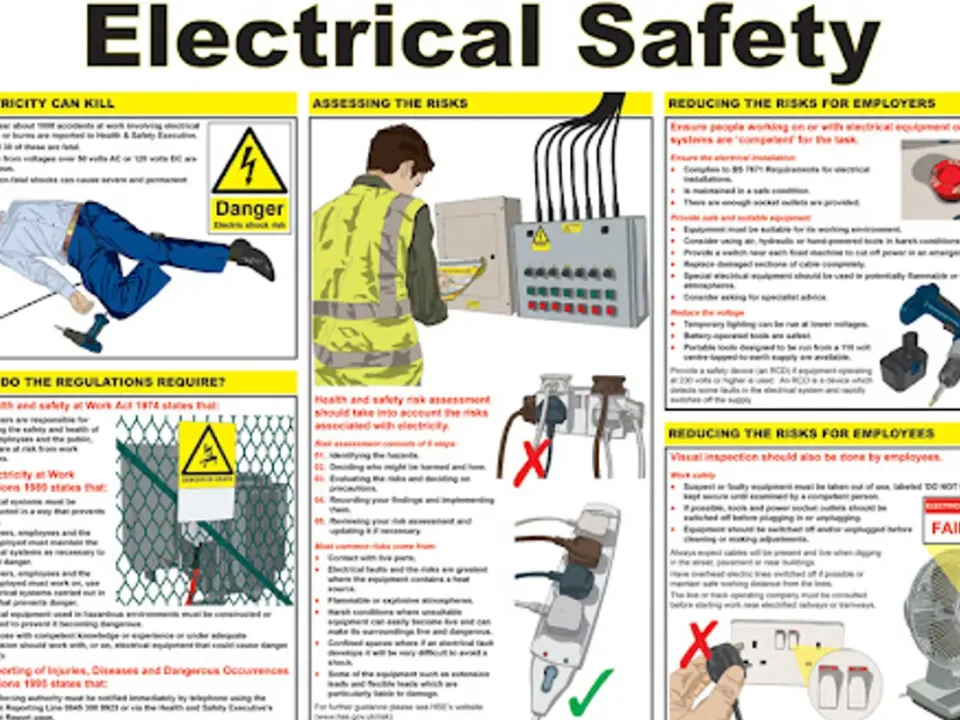From Spark to Blaze: Unraveling the Science Behind Electrostatic Fires and Explosions

Understanding Safety Integrity Level Assessment: Ensuring Faultless Industrial Safety
July 17, 2023
Empowering Safety Champions: Insights from The Safety Master
July 17, 2023From Spark to Blaze: Unraveling the Science Behind Electrostatic Fires and Explosions
Electrostatic fires and explosions have long perplexed scientists and engineers, posing a significant risk in various industries. The mere mention of these phenomena ignites a sense of curiosity and concern, urging us to delve deeper into the science behind these fiery events. In this enlightening exploration, we will embark on a journey from spark to blaze, unraveling the intricate mechanisms that underlie electrostatic fires.
As we venture into the realm of electrostatics, prepare to be captivated by the interplay between charged particles and combustible substances. We will demystify the complex processes that give rise to sparks and flames, shedding light on how seemingly innocuous interactions can lead to catastrophic consequences. But fear not – for amidst the dangers lies hope. By comprehending these scientific principles and adopting preventive measures, we can pave the way towards a safer tomorrow.
Understanding the Spark: Exploring the Basics of Electrostatic Fires
Embark upon a fascinating journey into the realm of electrostatic fires, where we seek to unravel the enigmatic nature of that initial spark. At its core, electrostatic fires arise from an intriguing phenomenon known as triboelectric charging, which occurs when two dissimilar materials come into contact and exchange electrons.
Picture this: imagine rubbing a balloon against your hair, only to witness it sticking to the wall afterward. What seemed like mere playfulness is in fact a manifestation of triboelectric charging in action. This simple act generates an imbalance in charge between the balloon and your hair, leading to an accumulation of static electricity.
In essence, understanding how these sparks come to be requires delving into the intricacies of charge separation caused by friction between materials. As we explore further into this captivating subject matter, we will unravel the complexities behind electrostatic discharges and uncover their role as ignition sources for combustible substances.
It Starts with Friction: Unveiling the Science Behind Electrostatic Charges
At the heart of every electrostatic fire lies an intriguing process rooted in the phenomenon of friction. When two objects come into contact and then separate, they exchange electrons. This intricate dance of atomic particles gives rise to the formation of electrostatic charges.
The science behind this phenomenon is a captivating journey through the microscopic world. As surfaces rub against each other, electrons are transferred from one material to another, leaving them either positively or negatively charged. These charges build up on the surface until they reach a critical point where they can no longer be contained.
This buildup of electric charge is where things start to get interesting. Once enough charge has accumulated, it seeks every opportunity to equalize or discharge itself. This release often occurs in the form of an electric spark, which can ignite flammable substances in its vicinity.
Unraveling the intricacies of electrostatic charges allows us to comprehend not only how sparks emerge but also how these humble beginnings can lead to catastrophic fires and explosions if proper precautions are not taken. By gaining a deeper understanding of this phenomenon, we pave the way for innovative solutions that minimize risks and enhance safety measures in various industries.
Sparks and Flames: How Electrostatic Discharges Ignite Combustible Substances
In the intricate web of electrostatic fires, it is the humble spark that ignites the flames of destruction. When an electrostatic discharge occurs, the release of electrons creates a momentary surge of energy that can set ablaze even seemingly inert materials. The intensity and duration of sparks play a pivotal role in determining the magnitude of combustion, making it imperative to comprehend their underlying mechanisms.
As electrified particles collide with combustible substances, they transfer their electric charge, creating a localized buildup of energy. This accumulated charge seeks to balance itself by jumping to nearby areas with lower potential. It is during this leap that sparks are born. These minuscule bursts of light and heat carry immense power, capable of breaking chemical bonds within flammable compounds and triggering exothermic reactions.
From Flame to Blaze: The Chain Reaction of Electrostatic Fires and Explosions
The transformation from a mere spark to a raging blaze is an intricate process that unfolds with astonishing speed in the realm of electrostatic fires. Once an electrostatic discharge occurs, it ignites the volatile atmosphere, setting off a cascade of events that can lead to catastrophic consequences. Understanding this chain reaction is crucial for preventing and mitigating the risks associated with electrostatic fires.
When an initial spark ignites a combustible substance, it triggers the release of energy in the form of heat. This heat, in turn, provides the necessary conditions for surrounding materials to reach their ignition temperature. As these materials catch fire, they liberate additional flammable gases or vapors, further fueling the flames. The intensified blaze generates even higher temperatures, causing neighboring substances to undergo thermal decomposition and produce additional combustible gases.
The Hidden Danger: Identifying Workplace Situations Prone to Electrostatic Hazards
Within the intricate tapestry of workplace hazards, electrostatic dangers remain hidden, lurking in the midst of daily operations. These subtle threats have the potential to unleash catastrophic consequences if not recognized and mitigated in a timely manner. Identifying workplace situations prone to electrostatic hazards requires a keen eye for detail and an understanding of the underlying principles.
One such situation arises when handling and transferring flammable liquids or powders. When these substances flow rapidly through pipes or equipment, friction and turbulence can generate significant static charges. In dusty environments, suspended particles can also accumulate charges, creating an invisible minefield of potential disaster. It is crucial to be aware of these activities and employ proper grounding techniques, bonding procedures, and conductive equipment to dissipate static electricity effectively.
Eliminating the Risk: Effective Strategies for Preventing Electrostatic Fires
In the pursuit of a safer working environment, implementing robust strategies to prevent electrostatic fires is paramount. By understanding the underlying causes and employing proactive measures, potential hazards can be mitigated, ensuring both personnel safety and business continuity.
One fundamental strategy involves minimizing static charge accumulation through proper grounding techniques. Establishing a comprehensive grounding system that connects all conductive elements in the working area ensures the dissipation of excess charges, reducing the risk of spark generation. Conductive flooring, grounded equipment, and regular inspections of grounding connections are essential components in this endeavor.
Moreover, eliminating or controlling flammable substances is crucial. Implementing strict protocols for handling and storing such materials minimizes the likelihood of ignition from electrostatic discharges. Utilizing appropriate containers with bonding and grounding provisions, along with investing in explosion-proof storage facilities, significantly reduces the chances of catastrophic incidents.
Education and training are vital tools in preventing electrostatic fires. By providing comprehensive awareness programs to employees regarding potential risks and best practices for handling electrostatics safely, organizations foster a culture of vigilance and responsibility. Regular training sessions that cover topics such as proper grounding techniques, safe handling procedures for flammable substances, as well as emergency response protocols empower employees to play an active role in preventing accidents.
Safety First: Essential Protective Measures and Equipment for Handling Electrostatics
When it comes to dealing with the potential hazards of electrostatic fires, prioritizing safety is of utmost importance. Employing a comprehensive range of protective measures and utilizing the correct equipment can greatly minimize the risk involved in handling electrostatics.
First and foremost, it is essential to establish proper grounding systems. Ensuring that all conductive objects are effectively grounded helps prevent the buildup of electrostatic charges. This can be achieved by utilizing grounded mats, conductive flooring, or installing grounding straps on equipment.
In addition to grounding, implementing proper bonding techniques is crucial. By connecting all conductive objects together with bonding wires or cables, any potential difference in voltage between them is equalized. This reduces the likelihood of hazardous discharges occurring.
Furthermore, personal protective equipment (PPE) plays a vital role in safeguarding individuals from harm. Wearing antistatic clothing made from materials such as carbon fiber or cotton blended with conductive fibers helps dissipate static charges and prevents sparks from igniting flammable substances. Additionally, using antistatic footwear and gloves further minimizes the risk of electrical discharges.
In situations where there is a considerable risk of electrostatic fires or explosions, specialized equipment such as explosion-proof containers or cabinets should be utilized to store and handle flammable substances safely. These robustly designed enclosures are constructed to withstand potential ignition sources and contain any accidental releases effectively.
To enhance overall safety, advanced technologies like static control monitoring systems can be employed. These systems continuously monitor electrostatic conditions within a given environment and provide real-time alerts if thresholds are exceeded
Innovation in Action: How Cutting-Edge Technologies Tackle Electrostatic Fire Risks
In our quest for safety, technology has emerged as a formidable ally against the perils of electrostatic fires and explosions. Groundbreaking innovations have paved the way for ingenious solutions that not only mitigate risks but also inspire confidence in industrial settings. One such revolutionary development is the electrostatic discharge (ESD) control system, which acts as a vigilant guardian against potential sparks that can ignite flammable substances.
The ESD control system employs an array of sensors strategically placed throughout the workspace to monitor the electrostatic charge levels. These sensors are connected to a central control unit that analyzes and interprets data in real-time, allowing for swift detection of any hazardous build-up of static electricity. Upon identifying an elevated risk level, this cutting-edge technology triggers an immediate response, such as activating grounding mechanisms or neutralizing charges with ionization devices.
Emergencies Unveiled: Emergency Action Plan for Electrostatic Fire Incidents
In the event of an electrostatic fire incident, having a well-prepared and effective emergency action plan is crucial. These plans are meticulously crafted to ensure the safety of personnel and minimize potential damages. The first step in developing such a plan is to conduct a comprehensive risk assessment, identifying potential sources of electrostatic hazards and vulnerable areas within the facility.
Once the risks have been identified, it is imperative to establish a clear chain of command and designate responsible individuals who will take charge during emergencies. These individuals should undergo specialized training to understand the intricacies of electrostatic fire incidents and execute actions swiftly and efficiently. Regular drills and simulations should also be conducted to reinforce preparedness among staff members.
Spreading Awareness: Collaborative Efforts in Promoting Electrostatic Fire Safety
When it comes to tackling the risks associated with electrostatic fires and explosions, a collective effort is crucial. Spreading awareness about these potential dangers and promoting fire safety measures is a responsibility shared by individuals, organizations, and governing bodies alike.
One of the most effective ways to raise awareness is through educational campaigns targeting both professionals and the general public. Workshops, seminars, and training sessions can be organized to educate workers about the science behind electrostatic fires, highlighting preventive measures that can be implemented in various industries. By equipping employees with knowledge on proper handling of electrostatics and emphasizing the importance of safe practices, we empower them to become vigilant guardians against potential fire hazards.
In addition to education, collaboration between industry experts plays a vital role in disseminating information on electrostatic fire safety. Research institutions partner with regulatory agencies to conduct studies aimed at identifying new preventive strategies or improving existing ones. Industry associations join forces to develop guidelines that can be adopted by businesses operating in similar sectors, ensuring uniformity in implementing best practices.
Awareness campaigns should also extend beyond workplaces through public service advertisements and social media platforms. By engaging the wider community, we foster an environment where everyone understands their role in preventing electrostatic fires. Emphasizing success stories of organizations that have effectively implemented safety protocols not only highlights good practices but also inspires others to follow suit.
In conclusion, spreading awareness about electrostatic fire safety requires collaborative efforts on multiple fronts – from educating individuals within industries to fostering partnerships between various stakeholders. By working together towards this common goal, we can create safer environments where the risks



